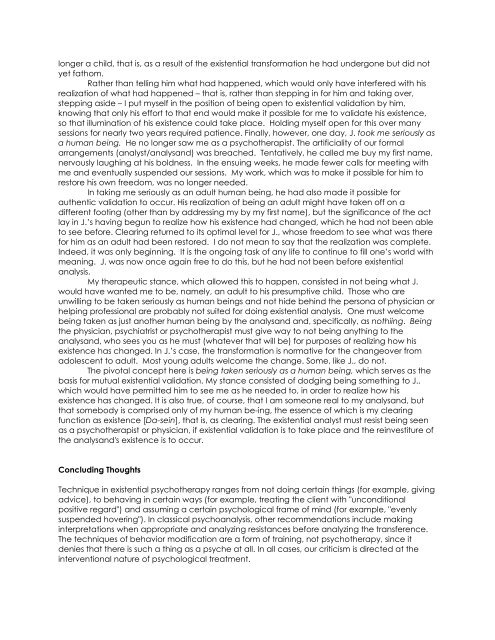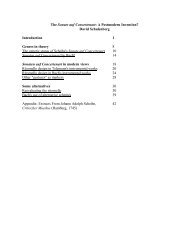SEVEN PAPERS ON EXISTENTIAL ANALYSIS ... - Wagner College
SEVEN PAPERS ON EXISTENTIAL ANALYSIS ... - Wagner College
SEVEN PAPERS ON EXISTENTIAL ANALYSIS ... - Wagner College
You also want an ePaper? Increase the reach of your titles
YUMPU automatically turns print PDFs into web optimized ePapers that Google loves.
longer a child, that is, as a result of the existential transformation he had undergone but did not<br />
yet fathom.<br />
Rather than telling him what had happened, which would only have interfered with his<br />
realization of what had happened – that is, rather than stepping in for him and taking over,<br />
stepping aside – I put myself in the position of being open to existential validation by him,<br />
knowing that only his effort to that end would make it possible for me to validate his existence,<br />
so that illumination of his existence could take place. Holding myself open for this over many<br />
sessions for nearly two years required patience. Finally, however, one day, J. took me seriously as<br />
a human being. He no longer saw me as a psychotherapist. The artificiality of our formal<br />
arrangements (analyst/analysand) was breached. Tentatively, he called me buy my first name,<br />
nervously laughing at his boldness. In the ensuing weeks, he made fewer calls for meeting with<br />
me and eventually suspended our sessions. My work, which was to make it possible for him to<br />
restore his own freedom, was no longer needed.<br />
In taking me seriously as an adult human being, he had also made it possible for<br />
authentic validation to occur. His realization of being an adult might have taken off on a<br />
different footing (other than by addressing my by my first name), but the significance of the act<br />
lay in J.’s having begun to realize how his existence had changed, which he had not been able<br />
to see before. Clearing returned to its optimal level for J., whose freedom to see what was there<br />
for him as an adult had been restored. I do not mean to say that the realization was complete.<br />
Indeed, it was only beginning. It is the ongoing task of any life to continue to fill one’s world with<br />
meaning. J. was now once again free to do this, but he had not been before existential<br />
analysis.<br />
My therapeutic stance, which allowed this to happen, consisted in not being what J.<br />
would have wanted me to be, namely, an adult to his presumptive child. Those who are<br />
unwilling to be taken seriously as human beings and not hide behind the persona of physician or<br />
helping professional are probably not suited for doing existential analysis. One must welcome<br />
being taken as just another human being by the analysand and, specifically, as nothiing. Being<br />
the physician, psychiatrist or psychotherapist must give way to not being anything to the<br />
analysand, who sees you as he must (whatever that will be) for purposes of realizing how his<br />
existence has changed. In J.’s case, the transformation is normative for the changeover from<br />
adolescent to adult. Most young adults welcome the change. Some, like J., do not.<br />
The pivotal concept here is being taken seriously as a human being, which serves as the<br />
basis for mutual existential validation. My stance consisted of dodging being something to J.,<br />
which would have permitted him to see me as he needed to, in order to realize how his<br />
existence has changed. It is also true, of course, that I am someone real to my analysand, but<br />
that somebody is comprised only of my human be-ing, the essence of which is my clearing<br />
function as existence [Da-sein], that is, as clearing. The existential analyst must resist being seen<br />
as a psychotherapist or physician, if existential validation is to take place and the reinvestiture of<br />
the analysand's existence is to occur.<br />
Concluding Thoughts<br />
Technique in existential psychotherapy ranges from not doing certain things (for example, giving<br />
advice), to behaving in certain ways (for example, treating the client with "unconditional<br />
positive regard") and assuming a certain psychological frame of mind (for example, "evenly<br />
suspended hovering"). In classical psychoanalysis, other recommendations include making<br />
interpretations when appropriate and analyzing resistances before analyzing the transference.<br />
The techniques of behavior modification are a form of training, not psychotherapy, since it<br />
denies that there is such a thing as a psyche at all. In all cases, our criticism is directed at the<br />
interventional nature of psychological treatment.















